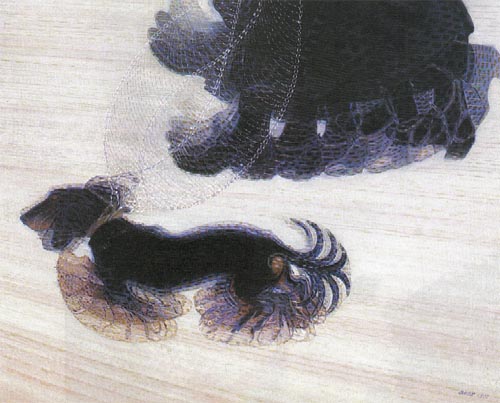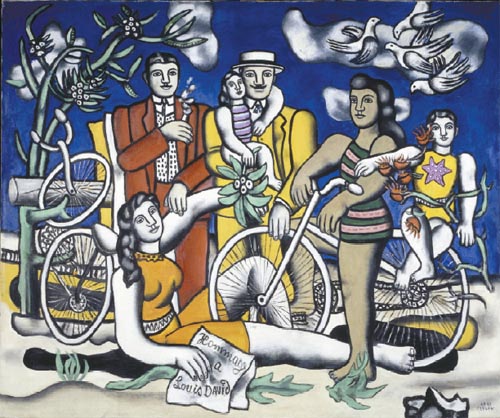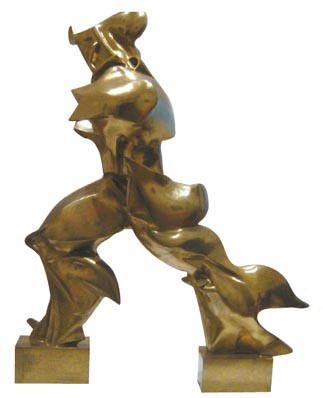Modern art’s love affair with machines

‘Dynamism of a Dog on a Leash’ (1912) by Giacomo Balla. Oil on canvas. Albright-Knox Art Gallery, Buffalo, New York.
Whenever I look at the painting “Dynamism of a Dog on a Leash,” by Italian artist Giacomo Balla (1871-1958), I can’t help but smile. The dog’s feet and the woman remind me of the Coyote’s ever-lasting pursuit of the Road Runner in Looney Tunes cartoons.
Balla himself must not have made this painting without a smile. Still, it is a serious painting rather than a joke. This piece is a result of the struggles that artists in the early 20th century went through to express the high speed of modern society.
Inspired by Etienne-Jules Marey’s photos, in which several consecutive phases of movement by an animal or human were recorded in each frame, Balla included a number of afterimages of feet, tail, leash and other moving things. These afterimages help viewers feel the speed and dynamics of moving objects that cannot be felt in ordinary paintings.
Seeing Balla’s painting, viewers are sure to chuckle as they recall images of a short-legged Dachshund scurrying to keep up with its owner.
Balla and other artists of the early 20th century were feeling a need to create new images in the midst of their suddenly-changed visual environment. Their surroundings no longer stood still for hours as in the landscape paintings of the old masters.
The Italian poet Filippo F. Marinetti (1876-1944) described the noise of a chaotic modern city bustling with cars as the “crisscross of trrrr trrrrr Elevated trrrr trrrrr overhead trrrombone whissstle ambulance sirens and firetrucks transformation of the streets into splendid corridors to guide push logic necessity.” He described the splendid illuminations and neon signs he saw as “red red red blue violet huge letter-eels of gold purple diamond fire.”
The artists of the early 20th century felt the need to find ways to effectively depict such dizzying new visual experiences in their works and to show new perspectives and compositions that were different from photographs in order to compete with the new art form.
What has followed since are paintings that are seemingly inscrutable in their depictions of objects or who knows what - in other words, modern art.

“Leisure: Homage to Louis David (1948)” by Fernand Leger. Oil on canvas. La Musee National d’Art Moderne du Centre Pompidou, Paris.
In the early 20th century, there were two representative groups of artists who experimented with reconstructing their visual experiences in their work. The first group was the Cubists, including Pablo Picasso (1881-1973), who worked mainly in France. The second was the Futurists led by Filippo Tommaso Marinetti (1876-1944) in Italy. Balla belonged to the latter group.
Picasso’s Cubist paintings show a combination of views from the front, side, top and other angles that, together, create a synthetic image.
On the other hand, the Futurists focused more on the dynamism of moving objects. They showed this through the use of afterimages and by overlapping the objects.
The Futurists were enthusiastic about the speed, power and freshness of the new machine civilization. They not only despised but nearly rejected classical art and all old things.
In truth, the attitude of the Futurists was far removed from the cuteness in Balla’s Dynamism of a Dog on a Lease. These artists were like immature teenagers obsessed with speed, and they had a kind of fantasy about extreme events in which old things would be destroyed and a revolution of speed and force would occur - in other words, what they dreamed of was war.
In his 1909 “Futurist Manifesto” Marinetti said, “We want to glorify war - the only cure for the world.”

“Unique Forms of Continuity in Space” (1913) by Umberto Boccioni. Bronze. Museum of Modern Art, New York.
I would be curious to know whether Boccioni maintained his positive view about war even at the moment of his death.
Boccioni’s death was a big loss for the art world because he was such an excellent artist. His sculpture “Unique Forms of Continuity in Space” shows a human form walking. The figure’s afterimages are depicted as contours along the back, extended and blown out of proportion.
The sculpture’s outline looks as though the material is fluttering lightly in the wind, even though it is made of heavy bronze. This enables viewers to feel the power that drives such a heavy object forward. The artist’s skill is truly worthy of respect.
Although the Futurists were creative like that, they have not gained as much recognition as the Cubists in art history. That is probably because the Futurists were advocates of war, and Marinetti supported the Fascist Benito Mussolini - a fact that makes him worthy of the scorn from those who experienced the miseries of the Second World War.
Some art historians point out that, during the time when the Futurists were active, Italy was falling behind in industrialization compared to other European countries. That could be the reason why the Futurists were unable to see the dark side of the machine age.
But the Futurists of Italy were not the only artists to fall in love with machines. The French Cubist Fernand Leger (1881-1955) had a positive view of the machine age.
Leger, a socialist, believed that the machine age would give workers more free time, rather than eliminating their jobs, as others believed. He even depicted human figures as machines in his paintings.
His painting “Leisure: Homage to Louis David” reflects this view. The painting is known in Korea because it was included in a special exhibition from La Musee National d’Art Moderne du Centre Pompidou two years ago.
Leger escaped to the United States when World War II broke out. While he was there, he was seduced by America’s capitalistic civilization. In particular, he was attracted by the “indecent” clothing worn by Americans on outings - brightly colored sweaters or short pants for hiking and bicycle trips - which are all reflected in the painting.
Leger’s painting reflects both his socialist ideology and his experience in America.
According to the Pompidou Centre, the painting was made in support of paid vacations for workers. By introducing the idea of the paid vacation, he is hoping that workers will be able to enjoy leisure, which was previously the privilege of noblemen and the bourgeoisie, and that an Arcadia would be created for them.
The many environmental artists of today make us believe that artists have always been against the idea of a machine civilization.
But it’s easy to forget that there once were artists who loved machines. In fact, it was their life’s work.
By Moon So-young [symoon@joongang.co.kr]
Related Korean Article
속도를 어떻게 그릴 것인가? 사진의 도전에 맞서다
문소영 기자의 명화로 보는 경제사 한 장면 <15> 기계를 사랑한 화가들
이탈리아 화가 자코모 발라(1871~1958)가 그린 ‘목줄을 한 개의 역동성’(사진 1)을 보면 웃음부터 나온다. 루니 툰스 만화에서 코요테와 로드러너가 쫓고 쫓기면서 수많은 발을 보이며 쌩 하고 달려가는 장면 같아서 말이다. 또는 그걸 대담무쌍하게도 실사로 재현한 주성치 영화 ‘쿵푸 허슬’ 장면이라든지.
발라 자신도 이 그림을 전혀 웃음 없이 그리진 않았을 것 같지만, 그래도 이 그림은 사뭇 진지한 작품이다. 20세기 초 화가들이 어떻게 하면 새로운 문명의 속도감을 화폭에 담을 수 있는지 고민한 것에 대한 한 가지 답인 것이다.
이 그림은 19세기 말에 처음 나온 연속동작 사진, 즉 한 장의 인화지에 인간이나 동물의 움직임을 연속적으로 기록한 사진에서 영감을 받았다. 이렇게 움직이는 존재의 여러 잔상이 한 화면에 나타나면 보통의 그림이나 사진에서 느끼기 힘든 속도감과 역동성이 느껴진다. 발라의 그림 또한 닥스훈트 강아지가 짧은 다리를 재게 놀려 쫄랑쫄랑 주인을 따라가는 움직임을 생생하게 전달해서 보는 사람을 미소 짓게 만든다. …
http://sunday.joins.com/article/view.asp?aid=19132










with the Korea JoongAng Daily
To write comments, please log in to one of the accounts.
Standards Board Policy (0/250자)